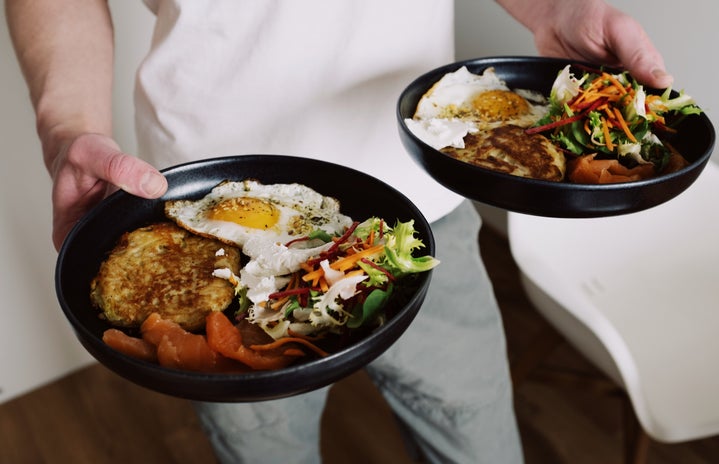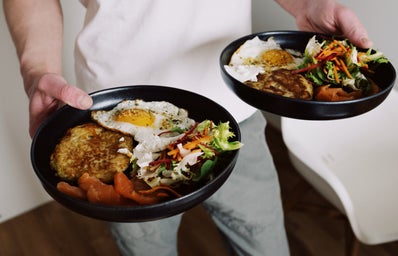Ah, food Instagram. The land of saturated green salads, carefully arranged charcuterie, mouth-watering snapshots of peanut noodles, and recipes for every possible flavor of overnight oats. The foodie corner of Instagram, like the site as a whole, is simultaneously aesthetically pleasing, entertaining, insecurity-inducing, and somewhat harmful.
But before I explain myself, let me offer my credentials. From March 2020 to July 2021, I maintained an Instagram food blog @laurasxceats, where I regularly shared pictures of meals I cooked at home. I gained a modest following, but I also became a devoted follower of many other blogs—my favorites were @carolinagelen, @halfbakedharvest, @chez.jorge, and @thecuttingveg. Those bigger accounts often had cookbook deals, or sponsorships, or were full-time chefs. In between their eminent presences were the scrappy home bloggers like me, sharing photos to a few enthusiastic commenters and a smattering of likes.
I haven’t posted to my food blog in months. One reason is that I’m now in college, without access to the ingredients and tools I had in my kitchen at home. But the other reason is that I chose to stop. Don’t get me wrong, I still love to cook and eat good food, and sometimes I photograph what I make. But while I was posting every day to my food account, I noticed a pattern. Once I finished photographing a dish and posting it to my page, I would scroll through my feed, which was stocked with the newest photos of my fellow food bloggers’ meals. Clicking on a blogger’s profile, I could scroll through endless more recipes and food ideas meant to entice the eyes and the stomach. When I was bored or waiting in line or procrastinating, instead of scrolling through photos of my friends at the beach, I would peruse my food account feed. All-day, I was looking at pictures or videos of food.
And it didn’t stop there. On the explore page, Instagram’s algorithm recommends new posts to users based on what kind of content each user has shown interest toward (liking, following, commenting) in the past. Adjacent to foodie Instagram are several other niche areas of social media: fitness Instagram and diet Instagram, to start. Health, food, and calorie-consciousness are often closely linked, so it’s a safe bet that fitness and diet content might catch a food blogger’s eye. Sure enough, my explore page was soon full of workout routines, dietary “advice” (cheerful graphics warning readers to eat cauliflower rice instead of real grains or to remove the top slice of bread from a sandwich), sprinkled with occasional posts about self-love and intuitive eating. Particularly ubiquitous was the “what I eat in a day” trend, in which a blogger records every piece of food they have consumed that day. Sometimes, it would be a picturesque, filtered video consisting of one coffee, one power juice, and one salad; other times, it showed three varied meals with snacks in between.
The ultimate goal of food Instagram, I realized, was the aestheticization of eating, and by extension, of the content creator’s lifestyle. Of course, this kind of aestheticization was only possible with careful attention to what one was eating, the type of meticulous attention that made a dish worthy of Instagram praise. So after months of constant exposure to this kind of content, I started thinking more meticulously about my meals than I ever had before establishing my account. Suddenly, I needed to plan what I was eating the night before; foods I used to eat without a second thought came into question; days now seemed to center around meals rather than just including them.
According to a company study that Facebook whistleblower Frances Haugen revealed, 17% of teen girls feel that Instagram makes their eating disorders worse. A former product manager at Facebook, Haugen exposed swaths of internal communications and research from the social media giant earlier this fall. The detrimental effect of Instagram on female mental health is not a shock to most women I know; we’ve all seen the constant stream of manicured pictures, people posing to look the most conventionally attractive, edited arms and stomachs, and everything. But if that’s the most harmful side of Instagram, are other areas of content “safer”? It’s easy to imagine the diet-advice content that appeared on my explore page harming a viewer in recovery from an eating disorder or the scant “what I eat in a day” template sending someone into an anxiety spiral. But what about the from-scratch cakes or delicious stir-fry recipes or vegan macaroni and cheese photos—the simple pictures of food? Are those safe?
My answer: sometimes.
What plagued me while I was an avid foodstagrammer was the same issue that plagues those food bloggers who get a little too excited about filter options on their iPhones: over-saturation. It was too much. The ideas and information that we consume become what we think about, and because I was constantly consuming content about food, I thought about food. I thought about food more than I needed or wanted to, almost to the point of obsession. As we know from the Haugen leaks, time on social media shapes our mindsets. Immersing myself in the world of food Instagram changed my mindset toward food. Its imprints are still there today, even though I have stopped scrolling through the content: I pay more attention to what I’m eating, I pay more attention to what other people are eating, I judge them, I judge myself, I catch myself wondering, or dreading when my next meal will be, even when I’ve just had my last.
I haven’t even begun to address the plethora of issues entrenched in food Instagram and food media in general. Throughout 2020, for example, food media experienced a continuous and unfinished reckoning with its bias toward Western cooking and white content creators. In the context of the COVID-19 pandemic, the proliferation of at-home food blogs like my own stands in damning contrast to the pandemic’s devastation and the situations of essential workers who could not stay home. What I have chronicled here is simply my experience with food media, one I was fortunate to have.
This week for Thanksgiving, I was at home cooking up a storm of dishes. I took photographs of the finished meal, but I haven’t posted them anywhere except for one on my Snapchat story. Looking through my camera roll, at the honey butter rolls arranged in a cast-iron skillet, the sizzling green bean casserole, the bright-red homemade cranberry sauce, I realized that I had almost no pictures of my family. I want to remember the food, sure, but more importantly, I want to remember the reason I made it in the first place. I made sure to sneak a few pictures of them in the post-feast festivities—those aren’t for Instagram. They’re for me.


